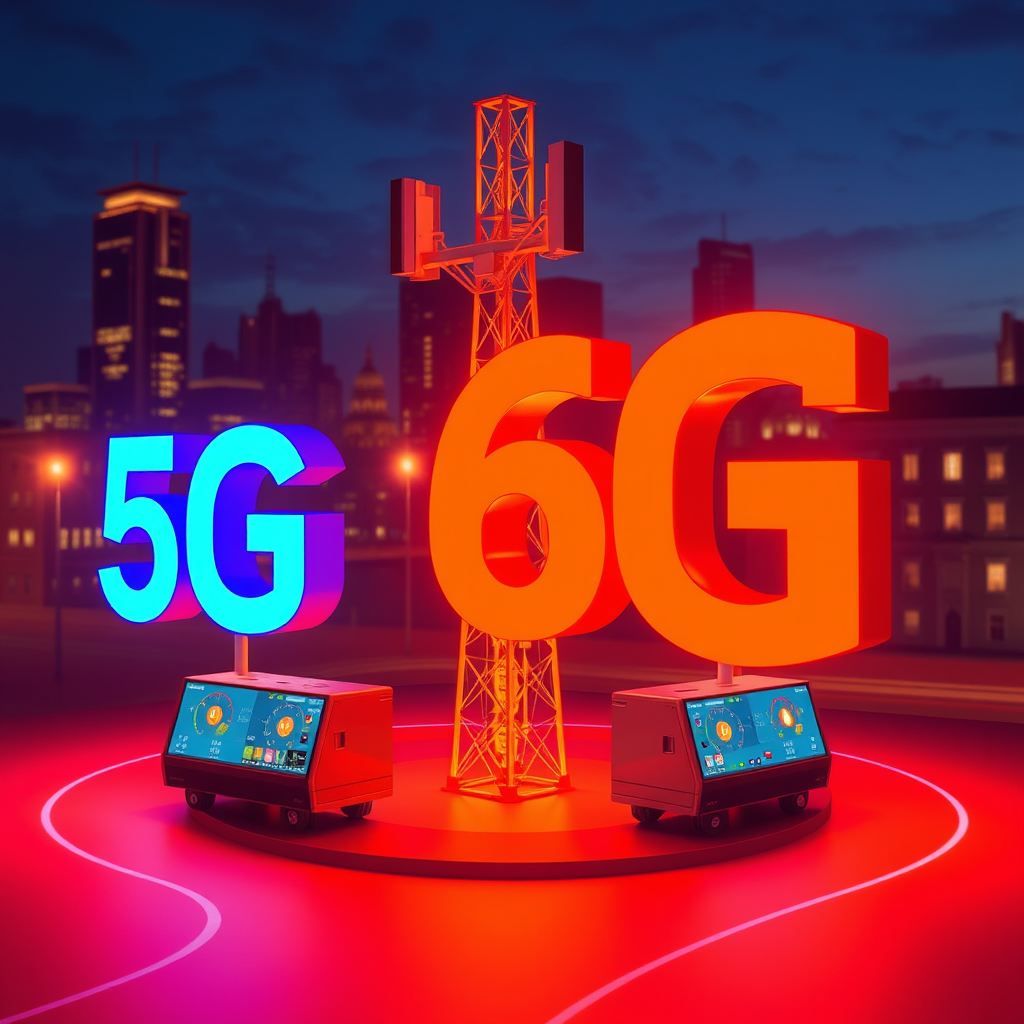What the future holds!
The advent of 5G technology marks a monumental leap in the evolution of mobile and wireless communication, reshaping how we connect, interact, and engage with the world around us. As the fifth generation of mobile networks, 5G promises to deliver unprecedented speeds, ultra-low latency, and the ability to connect a vast number of devices simultaneously. This technology is not just an incremental upgrade over its predecessors; it represents a radical transformation that could revolutionize industries, catalyze innovation, and empower the next wave of digital transformation.
At its core, 5G technology is designed to meet the growing demands of the digital age, where data consumption is soaring, and the need for real-time communication is critical. Unlike 4G, which primarily focused on improving mobile broadband speeds, 5G is a more versatile and comprehensive network. It aims to cater to a wide range of use cases, from enhanced mobile broadband (eMBB) to massive machine-type communications (mMTC) and ultra-reliable low-latency communications (URLLC). This flexibility makes 5G a foundational technology for the Internet of Things (IoT), autonomous vehicles, smart cities, and beyond.
The impact of 5G extends far beyond faster download speeds and improved connectivity. It is poised to be a key enabler of new business models, driving innovation in sectors like healthcare, manufacturing, transportation, and entertainment. For instance, 5G can facilitate remote surgery by providing real-time, high-definition video and haptic feedback to surgeons, or it can enable autonomous vehicles to communicate with each other and with infrastructure in real-time, ensuring safer and more efficient transportation.
Table of Contents
Why 5G Technology is Important
Examples and Practical Applications of 5G Technology.
Key Advancements in 6G Technology.
Comparative Table: 5G vs. Previous Technologies and Upcoming 6G Technology.
The importance of 5G cannot be overstated. As the world becomes increasingly digital, the ability to handle large volumes of data quickly and efficiently is crucial. 5G provides the infrastructure necessary to support this digital ecosystem, ensuring that we can continue to innovate and grow. Furthermore, as we look towards the future, the development of 6G technology is already on the horizon, promising even more advanced capabilities and further transforming the way we live and work.
In this article, we will delve deeper into what 5G technology is, its focus areas, its impact on various industries, and why it is so important. We will also explore practical applications of 5G, provide examples of how it is being used today, and compare it to previous generations of mobile networks as well as the upcoming 6G technology.
What is 5G Technology?
5G, or the fifth generation of wireless technology, is the latest iteration of cellular networks, designed to provide faster speeds, reduced latency, and more reliable connections. It is the successor to 4G LTE and is characterized by its ability to deliver data speeds up to 100 times faster than 4G, with latency as low as 1 millisecond. These capabilities are made possible through a combination of advanced technologies, including millimeter waves, small cells, massive MIMO (Multiple Input Multiple Output), beamforming, and full duplex.

One of the key features of 5G is its use of millimeter waves, which operate at higher frequencies than the radio waves used in previous generations. These higher frequencies can carry more data, but they have shorter ranges, necessitating the deployment of small cells—miniature base stations that can be placed closer together to ensure consistent coverage. Massive MIMO is another critical technology in 5G, utilizing multiple antennas to send and receive more data simultaneously, improving both capacity and efficiency. Beamforming helps direct signals to specific devices, reducing interference and enhancing the quality of the connection, while full duplex allows for simultaneous transmission and reception of data, doubling the efficiency of the network.
Focus Areas of 5G Technology
5G technology is designed to address three primary use cases, each targeting a different aspect of modern communication needs:
- Enhanced Mobile Broadband (eMBB): eMBB is focused on providing faster data speeds and more reliable connections for mobile devices. This aspect of 5G is what most consumers will experience first, as it improves everything from streaming high-definition videos to downloading large files in seconds. With eMBB, 5G is expected to support data-intensive applications such as augmented reality (AR) and virtual reality (VR), enabling more immersive experiences.
- Massive Machine-Type Communications (mMTC): mMTC addresses the need to connect a vast number of devices simultaneously, which is critical for the Internet of Things (IoT). As more devices become interconnected, from smart home gadgets to industrial sensors, mMTC ensures that these devices can communicate efficiently and reliably. 5G’s ability to support up to a million devices per square kilometer makes it ideal for smart cities, where everything from traffic lights to garbage bins could be connected and managed remotely.
- Ultra-Reliable Low-Latency Communications (URLLC): URLLC is perhaps the most transformative aspect of 5G, enabling real-time communication for critical applications. With latency as low as 1 millisecond, URLLC supports use cases where even the slightest delay could have significant consequences, such as autonomous vehicles, remote surgery, and industrial automation. This ultra-reliable communication is crucial for mission-critical applications that require instantaneous data transfer with minimal risk of interruption.
Impact of 5G Technology

The impact of 5G technology is profound, with the potential to revolutionize various industries and aspects of everyday life. Here are some of the key areas where 5G is expected to have a significant impact:
- Healthcare: 5G technology is set to transform the healthcare industry by enabling telemedicine, remote surgery, and real-time patient monitoring. With 5G’s low latency and high reliability, doctors can perform surgeries on patients thousands of miles away, using robotic arms controlled in real-time. Additionally, 5G can facilitate the use of wearable devices to monitor patients’ vital signs continuously, allowing for early detection of potential health issues and more personalized care.
- Automotive and Transportation: The automotive industry stands to benefit immensely from 5G, particularly in the development of autonomous vehicles. 5G enables vehicles to communicate with each other and with infrastructure in real-time, allowing for safer and more efficient driving. This technology also supports vehicle-to-everything (V2X) communication, which includes vehicle-to-vehicle (V2V), vehicle-to-infrastructure (V2I), and vehicle-to-pedestrian (V2P) interactions. These capabilities are crucial for the development of smart cities, where traffic management, parking, and public transportation systems can be optimized using 5G technology.
- Manufacturing and Industry 4.0: In the manufacturing sector, 5G is a key enabler of Industry 4.0, the fourth industrial revolution characterized by the integration of digital technologies into manufacturing processes. 5G supports the use of smart factories, where machines, robots, and sensors can communicate in real-time, enabling more efficient and flexible production. This technology also allows for predictive maintenance, where sensors can monitor equipment performance and predict when maintenance is needed, reducing downtime and improving productivity.
- Entertainment and Media: The entertainment industry is also set to be transformed by 5G, with new possibilities for immersive experiences. 5G supports the delivery of high-definition content with minimal buffering, enabling seamless streaming of 4K and even 8K videos. Additionally, 5G is expected to drive the adoption of AR and VR in gaming, live events, and other forms of entertainment, creating more interactive and engaging experiences for consumers.
- Smart Cities: 5G is a crucial technology for the development of smart cities, where infrastructure, services, and devices are interconnected to improve the quality of life for residents. 5G enables real-time monitoring and management of city services, such as traffic lights, waste management, and public safety. For example, smart traffic lights can adjust their timing based on real-time traffic data, reducing congestion and improving traffic flow. Additionally, 5G supports the deployment of smart grids, which can optimize energy distribution and reduce waste.
Why 5G Technology is Important
The importance of 5G technology lies in its ability to meet the growing demands of the digital age and support the next wave of innovation. Here are some of the key reasons why 5G is so important:
- Enabling the Internet of Things (IoT): 5G is the backbone of the IoT, a network of interconnected devices that communicate and exchange data. As more devices become connected, from smart home gadgets to industrial sensors, the need for a network that can handle this massive volume of data becomes critical. 5G provides the necessary infrastructure to support IoT, enabling new applications and services that can improve efficiency, convenience, and quality of life.
- Supporting New Business Models: 5G technology is expected to drive the development of new business models and revenue streams. For example, 5G can enable the use of augmented reality (AR) in retail, allowing customers to virtually try on clothes or visualize furniture in their homes before making a purchase. In the healthcare industry, 5G can support remote consultations and telemedicine services, providing access to healthcare for people in remote or underserved areas.
- Driving Digital Transformation: As the world becomes increasingly digital, the need for faster, more reliable communication networks is critical. 5G provides the infrastructure necessary to support digital transformation across industries, enabling the adoption of new technologies and processes that can improve efficiency, productivity, and customer experiences. For example, 5G can enable the use of artificial intelligence (AI) in manufacturing, allowing for real-time analysis of production data and more efficient decision-making.

- Enhancing Connectivity: 5G technology is designed to provide faster and more reliable connectivity, ensuring that people can stay connected even in the most demanding environments. Whether in densely populated urban areas, rural regions, or remote locations, 5G has the capability to provide consistent, high-speed internet access. This level of connectivity is essential not only for personal communication but also for businesses, governments, and various industries that rely on real-time data transmission and communication.
- Promoting Innovation and Economic Growth: The introduction of 5G is expected to act as a catalyst for innovation across various sectors, fostering the development of new technologies, products, and services. This innovation is likely to lead to the creation of new industries and job opportunities, contributing to economic growth on a global scale. As businesses adopt 5G technology, they can develop new services and applications that were previously not possible, leading to increased competitiveness and productivity.
- Enhancing Public Safety and Emergency Response: 5G technology has the potential to significantly improve public safety and emergency response capabilities. With its low latency and high reliability, 5G can support critical communication services, such as real-time video feeds from drones, which can be used to assess disaster sites or monitor large-scale public events. Additionally, 5G can enable the use of connected sensors and devices to monitor environmental conditions, detect potential hazards, and provide early warnings, helping to prevent accidents and save lives.

Examples and Practical Applications of 5G Technology
The real-world applications of 5G technology are vast and diverse, with many industries already exploring its potential. Below are some practical examples of how 5G is being used today:
- Smart Homes: 5G technology is revolutionizing the concept of smart homes by enabling seamless communication between connected devices. From smart thermostats and lighting systems to security cameras and home appliances, 5G ensures that all devices in a smart home ecosystem can communicate efficiently. This allows homeowners to control and monitor their homes remotely, improve energy efficiency, and enhance security.
- Remote Healthcare: One of the most promising applications of 5G technology is in remote healthcare. With 5G’s low latency and high bandwidth, healthcare providers can offer telemedicine services, allowing patients to consult with doctors and specialists from the comfort of their homes. Additionally, 5G enables the use of wearable devices that can continuously monitor patients’ vital signs and transmit data to healthcare providers in real-time, enabling early detection of health issues and timely intervention.
- Autonomous Vehicles: The development of autonomous vehicles is heavily reliant on 5G technology. 5G enables real-time communication between vehicles, infrastructure, and pedestrians, ensuring that autonomous vehicles can navigate safely and efficiently. This technology supports features such as adaptive cruise control, collision avoidance, and real-time traffic management, paving the way for a future where self-driving cars are the norm.
- Smart Manufacturing: In the manufacturing sector, 5G is enabling the concept of smart factories, where machines, robots, and sensors are interconnected and can communicate in real-time. This allows for more efficient production processes, predictive maintenance, and improved quality control. For example, a 5G-enabled factory can use AI and machine learning to analyze production data in real-time, identify potential issues, and optimize operations, leading to increased productivity and reduced downtime.
- Entertainment and Media: The entertainment industry is leveraging 5G technology to deliver new and immersive experiences to consumers. For instance, 5G enables the streaming of high-definition content with minimal buffering, allowing for seamless viewing of 4K and 8K videos. Additionally, 5G is driving the adoption of augmented reality (AR) and virtual reality (VR) in gaming, live events, and other forms of entertainment, creating more interactive and engaging experiences for users.
- Agriculture: 5G technology is also making an impact in agriculture by enabling the use of precision farming techniques. Farmers can use 5G-enabled sensors and drones to monitor crop health, soil conditions, and weather patterns in real-time, allowing them to make data-driven decisions and optimize their farming practices. This can lead to increased crop yields, reduced waste, and more sustainable farming methods.
Here Comes 6G
6G technology, the next frontier in wireless communication, is expected to build on the capabilities of 5G while introducing groundbreaking advancements that could fundamentally change the way we live, work, and interact with technology. While 5G is still in the process of global deployment, the anticipation surrounding 6G is growing, with researchers and industry leaders already exploring what this next generation of technology could bring. Here’s what we can expect from 6G and whether it’s worth waiting for:
Key Advancements in 6G Technology
- Terahertz Frequencies: 6G is expected to operate in the terahertz frequency range, which is significantly higher than the millimeter waves used in 5G. These ultra-high frequencies will enable even faster data transmission rates, potentially reaching speeds of up to 100 Gbps or more. This capability will be essential for applications that require vast amounts of data to be transmitted in real time, such as holographic communications and advanced virtual reality.
- AI-Driven Networks: Artificial Intelligence (AI) will be deeply integrated into 6G networks, making them more intelligent, adaptive, and efficient. AI will be used for optimizing network performance, managing resources, and even predicting and preemptively addressing potential issues before they occur. This will lead to more reliable and seamless connectivity, especially in dynamic environments where network conditions can change rapidly.
- Holographic Communication: 6G is expected to enable true holographic communication, where lifelike 3D holograms can be transmitted in real-time. This could revolutionize teleconferencing, entertainment, and education, allowing people to interact in virtual spaces as if they were physically present. Imagine attending a meeting, concert, or lecture with participants from around the world, all appearing as realistic holograms.
- Tactile Internet: The tactile internet, enabled by the ultra-low latency of 6G (as low as 0.1 milliseconds), will allow for real-time, remote control of devices and machines with haptic feedback. This could have profound implications for fields like medicine (e.g., remote surgery with tactile feedback), industrial automation, and even gaming, where users could physically interact with virtual objects.
- Enhanced IoT and Ubiquitous Connectivity: 6G will support a vastly expanded Internet of Things (IoT) ecosystem, with the ability to connect an unprecedented number of devices. This will lead to the creation of “smart everything”—from smart cities and smart homes to smart agriculture and smart healthcare. With 6G, the connectivity will be truly ubiquitous, allowing seamless integration of the physical and digital worlds.
- Environmental and Energy Efficiency: 6G networks are expected to be more energy-efficient than previous generations, leveraging AI and advanced technologies to reduce power consumption. This is crucial for supporting the massive number of connected devices and ensuring that the growth of digital infrastructure does not come at the expense of the environment. Additionally, 6G could incorporate green technologies that make the entire network more sustainable.
- Enhanced Security and Privacy: With the increased connectivity and data transmission speeds of 6G, there will also be a greater focus on security and privacy. 6G is expected to include advanced encryption methods, decentralized security models, and AI-driven threat detection to protect against increasingly sophisticated cyber threats.
Comparative Table: 5G vs. Previous Technologies and Upcoming 6G Technology
The following table compares 5G technology with previous generations (2G, 3G, 4G) and the upcoming 6G technology:
| Feature | 2G | 3G | 4G | 5G | 6G (Expected) |
| Deployment Year | 1991 | 2001 | 2009 | 2020 | 2030 (Estimated) |
| Data Speed | Up to 100 Kbps | Up to 2 Mbps | Up to 1 Gbps | Up to 10 Gbps | Up to 100 Gbps |
| Latency | 300 ms | 200 ms | 50 ms | As low as 1 ms | As low as 0.1 ms |
| Frequency Bands | 900 MHz | 1.8-2.1 GHz | 2-8 GHz | 24-100 GHz (millimeter waves) | Terahertz frequencies |
| Technology Focus | Voice Communication | Mobile Internet | Mobile Broadband | IoT, Smart Cities, AI, Autonomous Tech | AI-driven, Holographic Communication, Advanced IoT |
| Connectivity | Limited | Improved | Global Coverage | Massive Connectivity (mMTC) | Ubiquitous Connectivity |
| Applications | Voice Calls, SMS | Basic Web Browsing | HD Video Streaming, Mobile Apps | AR/VR, Autonomous Vehicles, Remote Surgery | Holography, Tactile Internet, Enhanced AI |
| Energy Efficiency | Low | Medium | Medium | High | Very High |
| Device Density | Low | Medium | High | Very High | Extremely High |
Should You Wait for 6G?
Whether or not to wait for 6G depends on your specific needs and goals. Here are some considerations:
- Current Needs and 5G Capabilities: If your current needs revolve around faster internet speeds, enhanced mobile broadband, IoT connectivity, or low-latency applications like gaming or remote work, 5G is already a significant upgrade from previous generations and will continue to evolve. 5G networks are capable of handling most of the current and near-future demands with great efficiency.
- Long-Term Vision: For industries and organizations with a long-term vision, especially those involved in cutting-edge research, technology development, or infrastructure planning, 6G represents a future opportunity to create truly transformative applications. However, it’s important to note that 6G is still in the research and development phase, with commercial deployment not expected until around 2030.
- Innovation Cycles: Technology evolves in cycles, and waiting for the “next big thing” can sometimes mean missing out on the current advancements. 5G will continue to be a powerful tool for innovation over the next decade, and many new products, services, and business models will be built on 5G networks. Investing in 5G now could position you to be ready to adopt 6G when it becomes available.
- Cost and Infrastructure: Implementing 5G infrastructure requires significant investment, and for most businesses and consumers, adopting 5G today makes sense to leverage the benefits immediately. Waiting for 6G might delay access to the benefits of next-gen connectivity, especially considering the extensive rollout timelines and infrastructure updates required for 6G.
6G technology promises to bring revolutionary changes that could reshape industries and daily life. From terahertz frequencies to AI-driven networks and holographic communication, 6G will offer capabilities far beyond what is possible today. However, since 6G is still in its conceptual and research stages, waiting for it may not be practical if you need the benefits of next-generation connectivity today.
5G is already here and is set to transform the digital landscape, driving innovation and economic growth across multiple sectors. For most users and businesses, adopting 5G now and preparing for the future of 6G is the best strategy. By the time 6G arrives, the infrastructure, experience, and applications built on 5G will provide a strong foundation to take full advantage of what 6G has to offer.

Summary
5G technology is more than just the next step in the evolution of mobile networks; it is a fundamental shift that has the potential to transform the way we live, work, and interact with the world around us. With its ability to deliver ultra-fast speeds, low latency, and massive connectivity, 5G is set to be a key enabler of the Internet of Things (IoT), autonomous vehicles, smart cities, and a host of other innovations that will define the digital future.
The importance of 5G lies in its ability to support the growing demands of our increasingly connected world, driving digital transformation across industries and fostering innovation on a global scale. As 5G technology continues to roll out and mature, we can expect to see a wave of new applications and services that were previously not possible, leading to increased efficiency, productivity, and convenience in every aspect of our lives.
Looking ahead, the development of 6G technology promises to build on the foundations laid by 5G, offering even more advanced capabilities and further transforming the way we live and work. While 6G is still in its early stages, the progress made with 5G has already set the stage for a future where connectivity is ubiquitous, and the possibilities for innovation are limitless.
In a nutshell, 5G is not just about faster internet speeds; it is about enabling a new era of technological advancement that will shape the future of our society. From healthcare and transportation to manufacturing and entertainment, the impact of 5G will be felt across all sectors, making it one of the most important technologies of our time. As we continue to explore the potential of 5G, we can look forward to a future where everything is connected, intelligent, and more efficient than ever before.
Curated for you





One thought on “5G Technology & Upcoming 6G”
Comments are closed.